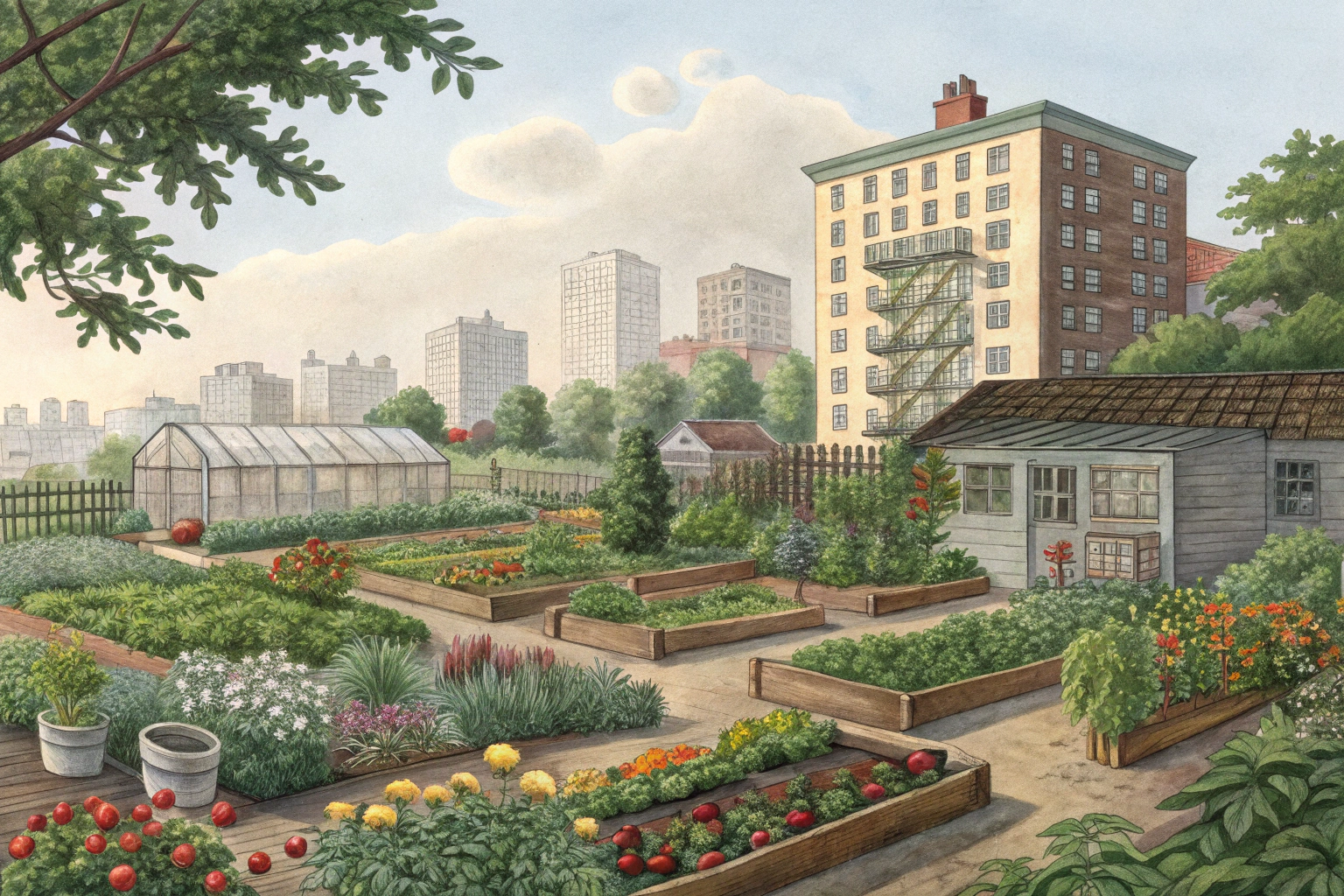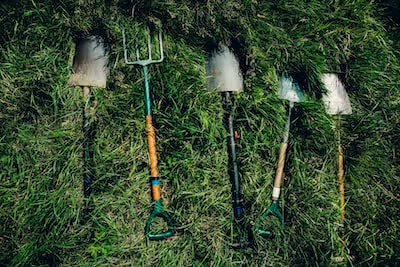Urban Homesteading: How to Grow Self-Sufficiency in Your City

Urban homesteading
Urban homesteading transforms city spaces by turning balconies, rooftops, and small yards into food-producing oases. Urban homesteading lets you grow tomatoes in containers, keep bees on a rooftop, or compost kitchen scraps—all within city limits. With urban homesteading, even the smallest patch or pot can nurture herbs, fruit, and vegetables for your table.
Get ready to reimagine your apartment or backyard as a source of sustenance and satisfaction—here’s how to begin.
Cheatsheet: Make the Most of Small-Space Self-Reliance
🌱 Grow Edibles Everywhere
- Use containers, raised beds, window boxes. Tomatoes, greens, herbs thrive in 6+ hours sun.
- Vertical growing increases yield. Use trellises, shelves, wall pockets.
- 1/8 acre (500 m²) can supply most fresh produce for a family of four.
🐔 Backyard Chickens & Bees
- Check city codes. 3 hens can lay 500+ eggs/year.
- Hive produces 20-60 lb (9-27 kg) honey/year. Pollinates your crops.
💧 Water & Soil Management
- Compost kitchen scraps for rich soil.
- Collect rainwater; use drip irrigation. Reduces city water use by up to 40%.
- Mulch reduces evaporation and weeds.
🥕 Preserve the Harvest
- Freeze, can, dry or ferment surplus. Increases shelf-life by 6–12 months.
- Stagger plantings for continuous crops.
🌡️ Climate & Space Hacks
- Grow lights extend seasons. South-facing windows boost winter greens.
- Espalier fruit trees fit against walls.
- Hydroponics yields up to 20% more per square foot (0.1 m²).
🛠️ Tools and Products You'll Need
- Hand trowel, pruners, gloves
- Compost bin, containers or beds, seeds, seedling trays
- Drip irrigation kit, watering can, rain barrel
- Chicken coop/beehive (if allowed), organic fertilizer
- Canning jars/lids, freezer bags, dehydrator (optional)
🌿 Nutrition & Self-Sufficiency Boost
- Homegrown veggies contain up to 40% more nutrients than store-bought.
- Cut grocery bills and reduce food miles.
- Preserve seasonal surplus to eat local year-round.
Urban Homesteading: Cultivating Abundance in the City
Why Urban Homesteading Thrives
Cities teem with opportunity for those who know where to look. Balconies, rooftops, and tiny patios transform into micro-farms with a bit of ingenuity.
A 2022 report from the National Gardening Association found 35% of American households now grow food at home, a sharp rise since 2016. Urbanites drive much of this change, craving fresher flavors and a personal connection to their food supply.
“Growing food in the city isn’t just possible—it’s revolutionary,” shares Ron Finley, the self-proclaimed Gangsta Gardener of Los Angeles.
I’ve harvested heirloom tomatoes in a window box so sun-drenched the fruit nearly caramelized on the vine. City heat works wonders if you exploit the microclimates hiding in plain sight.
Core Elements of Urban Homesteading
- Container gardening: Anything that drains works—wicker baskets, galvanized tubs, even repurposed plastic buckets. Just ensure at least 6 inches (15 cm) of soil depth for most edibles.
- Vertical gardening: I once trained pole beans to scale a fire escape, yielding pounds of crisp pods. Use trellises, wall planters, and hanging baskets to grow up instead of out.
- Composting: Indoor worm bins or bokashi systems turn scraps into black gold. The city compost bin under my sink hums along, feeding my soil and conscience alike.
- Rainwater harvesting: A 55-gallon (208-liter) barrel can save hundreds on water bills and let you irrigate during drought restrictions.
- Backyard chickens or quail: Don’t laugh—many cities now allow small flocks. Quail thrive in coops the size of a dog crate and lay eggs daily.
Soil and Sunlight: The Urban Grower’s Currency
City soil often needs remediation. Raised beds or containers sidestep lead and other contaminants. Mix coco coir, compost, and perlite for a fluffy, nutrient-rich blend.
Sunlight pulses strongest on south or west-facing walls. Track the arc for a week—six hours daily will satisfy tomatoes and peppers; leafy greens tolerate partial shade.
Top 5 Crops for Urban Homesteaders
- Herbs: Basil, mint, and chives practically grow themselves on windowsills.
- Lettuce mixes: Cut-and-come-again blends give repeat harvests in shallow trays.
- Cherry tomatoes: Indeterminate varieties, like ‘Sungold,’ thrive in containers.
- Peppers: Compact cultivars such as ‘Lunchbox’ peppers fruit heavily all summer.
- Radishes: They mature in 25 days. Instant gratification in gardening.
Last spring, I squeezed nine pepper plants into a single 15-gallon (57-liter) grow bag. The yield—buckets of sweet, blazing fruit—proved space means nothing compared to sunlight and attention.
Commercial Tools: What’s Worth Buying?
- Self-watering planters: These cut watering chores in half. My favorite, the EarthBox, turned a parking lot corner into a salad factory.
- Grow lights: Full-spectrum LEDs simulate summer in winter. I start every seedling under these, coaxing stubborn peppers and basil even when January drags on.
- Soil test kits: Don’t guess. A $15 kit saves seasons of disappointment and tells you exactly what amendments are needed for optimal nutrition.
Urban Homesteading Alternatives and Adjuncts
- Community gardens: For those with no home space, these plots offer social connection and soil access.
- Hydroponics: Grow vegetables without soil, using recirculating water and nutrients. Systems like Tower Garden fit right in a kitchen corner.
- CSA memberships: While not “grow your own,” many urbanites supplement their harvests with local farm shares.
Common Hurdles—and How to Outwit Them
Pigeons once decimated my arugula overnight. Floating row covers fixed that. For aphids, a strong blast of soapy water usually does the trick. Space constraints? Try succession planting: after radishes, sow beans in the same pot.
Sneaky squirrels or city regulations might test your patience. Still, the flavor of a homegrown cucumber, warm and prickly, trumps any bureaucratic headache.
Learning and Personalization
Every city plot has quirks. Personalized guidance helps maximize results. For tailored advice and step-by-step instructions, try Taim.io; I’ve used their app to troubleshoot everything from powdery mildew to seed starting times in my microclimate.
“Urban farming is street art for the soil,” says Novella Carpenter, author of Farm City. “Each season you get to paint it again.”
With a little moxie and the right tools, any city dweller can create a thriving patch of edible paradise.

Want smarter plant choices? 🪴
Frequently Asked Questions
How can I grow edible plants in small spaces without a traditional garden?
Container gardening works well on balconies, patios, or even sunny windowsills. Choose compact varieties of vegetables and herbs, such as cherry tomatoes, lettuces, or basil. Use deep containers for root crops like carrots, with at least 12 inches (30 cm) of soil depth. Vertical planters and wall-mounted pots also maximize space while increasing yield.
What vegetables thrive in urban environments with limited sunlight?
Leafy greens like spinach, kale, and chard tolerate partial shade. Herbs such as mint, parsley, and cilantro also do well without full sun. If your space receives less than 6 hours of sunlight, focus on crops labeled as shade-tolerant and rotate containers to catch light throughout the day.
How do I manage composting in an apartment or small backyard?
Worm bins (vermicomposting) fit easily indoors and break down food scraps into nutrient-rich castings. For outdoor spaces, compact bins with tight lids avoid odors and discourage pests. Balance green (food waste) and brown (paper, dried leaves) materials and keep the pile moist, like a wrung-out sponge. Optimal temperatures for decomposition remain between 90 to 140°F (32 to 60°C).
What are efficient watering strategies for urban gardens?
Install self-watering containers or set up a drip irrigation system with a timer to deliver moisture directly to roots. Early morning watering reduces evaporation and discourages fungal diseases. Mulch with shredded leaves or straw to retain soil moisture and regulate temperature.
How can I raise chickens or keep bees within city limits?
Check local ordinances for regulations on chickens or bees. Many cities allow hens (not roosters) and limit flock size. Provide a predator-proof coop with 2 to 3 square feet (0.2 to 0.3 m²) per bird inside and access to an outdoor run. For beekeeping, position hives away from neighbors and ensure bees have clean water nearby. Respect required setbacks, which often specify 5 to 15 feet (1.5 to 4.5 meters) from property lines.
How do I avoid common pest problems in a dense urban area?
Encourage beneficial insects like ladybugs and lacewings by planting diverse flowers. Use row covers to protect crops and remove any infested foliage promptly. Rotate crops each season and practice good sanitation by cleaning up debris and fallen fruit. For stubborn pests, apply insecticidal soap or neem oil during early morning or late evening hours.
Urban homesteading rewards the stubborn and the curious. Every tomato ripened on a balcony and every salad picked from a windowsill is a small act of independence. Tools like a sturdy hand trowel or a humble watering can matter as much as ambition. Respect the life cycle of your plants, get to know your growing zone, and lean into mistakes. The city’s chaos fades when you taste your own fresh herbs, or see pollinators drawn to your patch. Start small, try composting with kitchen scraps, or experiment with companion planting. You’re not just growing food—you’re reclaiming a piece of self-reliance. No secret handshake required. Just honest work, a little patience, and a willingness to learn from the dirt.
The Prepper’s Guide to Urban Homesteading: Self-Sufficiency Tactics
City living brings surprises—supply chain disruption, power outages, water alerts. Urban homesteading sustains you when grocery shelves empty. Build agility and resilience with these proven, low-space strategies.
Water Security Tactics
- Install a gravity-fed rainwater barrel; filter with activated carbon and ceramic for potable use. In one rainy season, a 50 gal/190 L barrel can fill dozens of times.
- Keep compact, shelf-stable water purification tablets as backup. A 10-pack treats up to 30 gal/115 L.
- Use greywater (from washing produce or dishes with eco-detergent) to irrigate non-edibles.
Off-Grid Food Resilience
- Convert a single windowsill to microgreens or sprouts—ready in 4–7 days, providing living enzymes and vitamins C, K, A.
- Store dehydrated soup mixes and home-canned beans. Both last 1–2 years unopened.
- Freeze, dry, or pickle garden excess in small glass jars for security against power loss.
Apartment-Friendly Power Backup
- Solar-powered lanterns and USB chargers fit balconies or window ledges; a 20W panel charges phones or fans.
- Invest in lanterns with replaceable batteries and a compact butane/alcohol camp stove for emergency meals.
Modular Indoor Growing
- Stackable hydroponic units yield leafy greens year-round. One square foot/0.1 m2 produces up to 25 heads per season.
- Grow mushrooms: oyster kits thrive in closets, producing 2 lb/1 kg flushes every 3 weeks.
Emergency Seed Banking
- Keep a vacuum-sealed packet of heirloom seeds in a cool, dark place. Germination rates remain high for 3-8 years.
- Date each packet and rotate use every season for continual viability.
Strategic Apartment Storage
- Use food-safe buckets with gamma lids for grains and legumes; oxygen absorbers extend shelf life to 5+ years.
- Vacuum-pack dried herbs and vegetables. One cubic foot/28 L stores a season’s supply for a two-person household.
Urban preparedness isn’t about waiting or wishing. It’s daily readiness—one container, one crop, one shelf at a time.
Find out which plants will thrive in your garden!
Answer a few fun questions and get custom plant recommendations perfect for your space. Let’s grow something amazing together!

start your season

%2520(3).avif)



